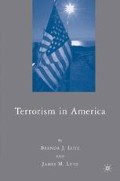Abstract
The colonial period in what was to become the United States was an era in which violence was all too common. There were numerous conflicts between settlers and Indians, some of which were part of the conflicts between Great Britain and other European colonial powers. In the colonies there were extralegal attempts to resolve political disputes through armed confrontations among colonists, divided on issues of political policy, political control, or religion. At times elections to colonial assemblies turned violent. Violent agitation against the Crown preceded the American Revolution; and Shays Rebellion and the Whiskey Rebellion occurred early in the history of the creation of the new country. Though not all of the violence from the colonial era qualifies as terrorism, some of it certainly does.
Access this chapter
Tax calculation will be finalised at checkout
Purchases are for personal use only
Preview
Unable to display preview. Download preview PDF.
Notes
Evan Haefeli, “Kieft’s War and the Cultures of Violence in Colonial America,” in Michael A. Bellesiles (ed.), Lethal Imagination: Violence and Brutality in American History (New York: New York University Press, 1999), pp. 26–7.
Faren R. Siminoff, Crossing the Sound: The Rise of Atlantic American Communities in Seventeenth Century Eastern Long Island (New York: New York University Press, 2004).
Richard Maxwell Brown, Strains of Violence; Historical Studies of American Violence and Vigilantism (Oxford: Oxford University Press, 1977), pp. 43–4.
W. Eugene Hollon, Frontier Violence: Another Look (New York: Oxford University Press, 1974), p. 8.
Joan de Lourdes Leonard, “Elections in Colonial Pennsylvania,” William and Mary Quarterly, 3rd Series, Vol. 11, No. 3 (1954), pp. 385–401, and William T. Parsons, “The Bloody Election of 1742,” Pennsylvania History, Vol. 36, No. 3 (1969), p. 290.
Paul A. Gilje, The Road to Mobocracy: Popular Disorder in New York City, 1763–1834 (Chapel Hill, NC: University of North Carolina Press for the Institute of Early American History and Culture, 1987), pp. 12–13; Richard Hofstadter and Michael Wallace (eds.), American Violence: A Documentary History (New York: Alfred A. Knopf, 1970), p. 60; and Edmund S. Morgan and Helen M. Morgan, The Stamp Act Crisis: Prologue to Revolution, 2nd ed. (New York: Collier Books, 1962), pp. 63, 159.
Brown, Strains of Violence, p. 113, and Rachel N. Klein, “Ordering the Backcountry: The South Carolina Regulation,” William and Mary Quarterly, 3rd Series, Vol. 38, No. 4 (1981), pp. 661–80.
Paul Bradley Davis, “American Experiences and the Contemporary Perception of Terrorism,” Small Wars and Insurgencies, Vol. 7, No. 2 (1996), p. 224; Division of Archives and History (State of New York), The American Revolution in New York: Its Political, Social and Economic Significance (Albany: The University of the State of New York, 1926), pp. 14–18; Robert Leckie, George Washington’s War: The Saga of the American Revolution (New York: Harper Collins, 1992), p. 49; Morgan and Morgan, Stamp Act Crisis, Chap. 8; and Lloyd I. Rudolph, “The Eighteenth Century Mob in America and Europe,” American Quarterly, Vol. 11, No. 4 (1959), p. 450.
Benson Bobrick, Angel in the Whirlwind: The Triumph of the American Revolution (New York: Simon and Schuster, 1977), p. 62.
Arthur Meier Schlesinger, “Political Mobs and the American Revolution, 1765–1776,” Proceedings of the American Philosophical Society, Vol. 99, No. 4 (1955), p. 246.
Bobrick, Angel in the Whirlwind, p. 75; Pauline Maier, “Popular Uprisings and Civil Authority in Eighteenth-Century America,” William and Mary Quarterly, 3rd series, Vol. 27, No. 1 (1970), p. 11; and David C. Rapoport, “The Four Waves of Rebel Terror and September 11,” in Kegley (ed.), New Global Terrorism, pp. 37–8.
Roger J. Champagne, “New York’s Radicals and the Coming of Independence,” Journal of American History, Vol. 51, No. 1 (1964), pp. 22–3.
Gordon S. Wood, “A Note on Mobs in the American Revolution,” William and Mary Quarterly, 3rd series, Vol. 23, No. 4 (1966), p. 640.
Richard B. Morris, “Insurrection in Massachusetts,” in Daniel Aaron, America in Crisis: Fourteen Crucial Episodes in American History (New York: Alfred A. Knopf, 1952), p. 29, and Alden T. Vaughan, “The ‘Horrid and Unnatural’ Rebellion of Daniel Shays,” in Roger Lane and John J. Turner (eds.), Riot, Rout, and Tumult: Readings in American Social and Political Violence, Contributions in American History No. 69 (Westport, CT: Greenwood Press, 1978), p. 58.
Thomas P. Slaughter, The Whiskey Rebellion: Frontier Epilogue to the American Revolution (New York: Oxford University Press, 1986), p. 103.
Leland D. Baldwin, Whiskey Rebels: The Story of a Frontier Uprising (Pittsburgh, PA: University of Pittsburgh Press, 1976), pp. 82, 84, 206; Jacob E. Cooke, “The Whiskey Insurrection: A Re-evaluation,” Pennsylvania History, Vol. 30 (1963), p. 317; Hollon, Frontier Violence, pp. 12–13; Slaughter, The Whiskey Rebellion, p. 113; and Bernard A. Weisberger, America Afire: Jefferson, Adams, and the Revolutionary Election of 1800 (New York: William Morrow, 2000), p. 113.
Lutz and Lutz, Terrorism: Origins and Evolution, pp. 25–6, 77, and Wilfried Nippel, “Policing Rome,” Journal of Roman Studies, Vol. 74 (1984), pp. 20–9.
Copyright information
© 2007 Brenda J. Lutz and James M. Lutz
About this chapter
Cite this chapter
Lutz, B.J., Lutz, J.M. (2007). The Colonial Era: Rebellion and Dissent. In: Terrorism in America. Palgrave Macmillan, New York. https://doi.org/10.1057/9780230608931_2
Download citation
DOI: https://doi.org/10.1057/9780230608931_2
Publisher Name: Palgrave Macmillan, New York
Print ISBN: 978-1-349-53532-3
Online ISBN: 978-0-230-60893-1
eBook Packages: Palgrave Political & Intern. Studies CollectionPolitical Science and International Studies (R0)

